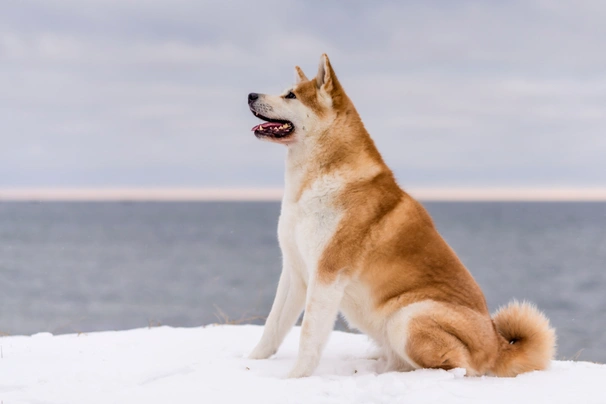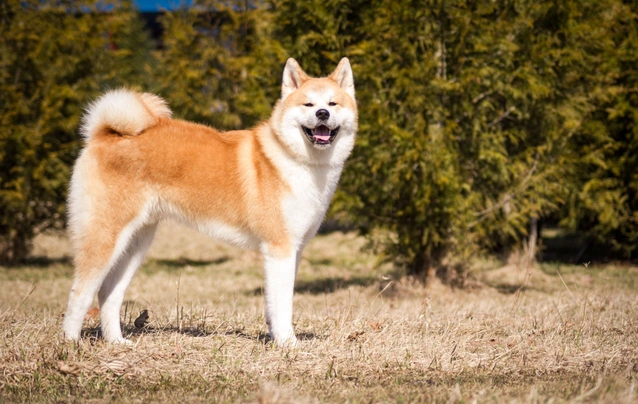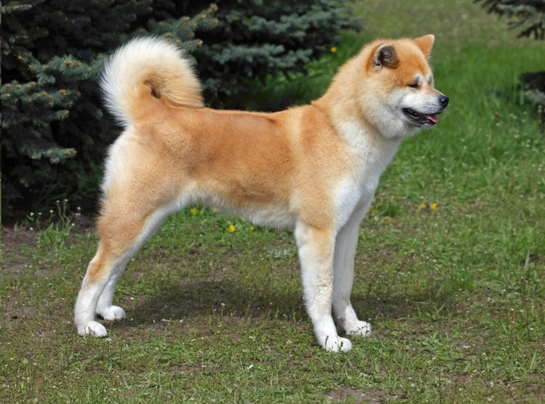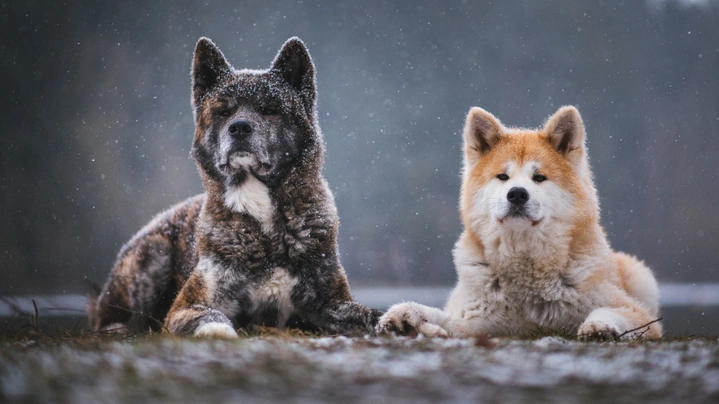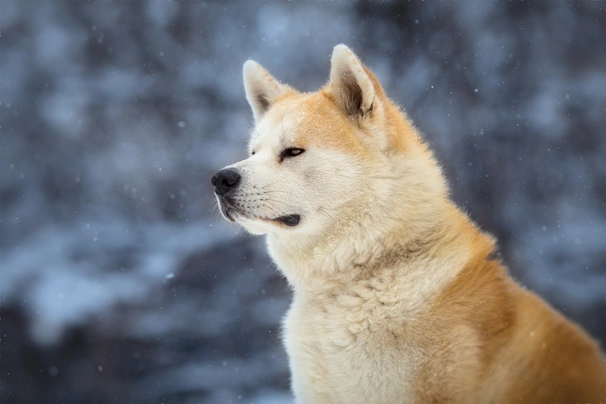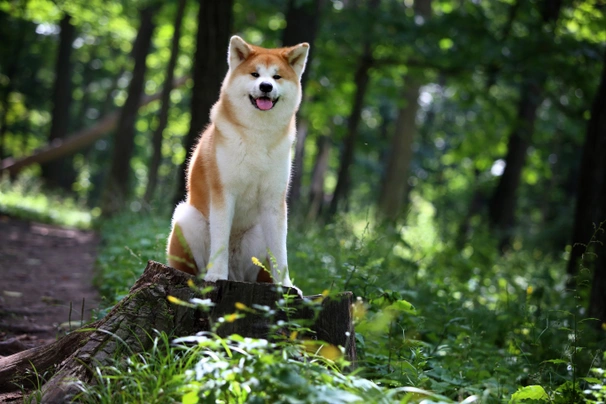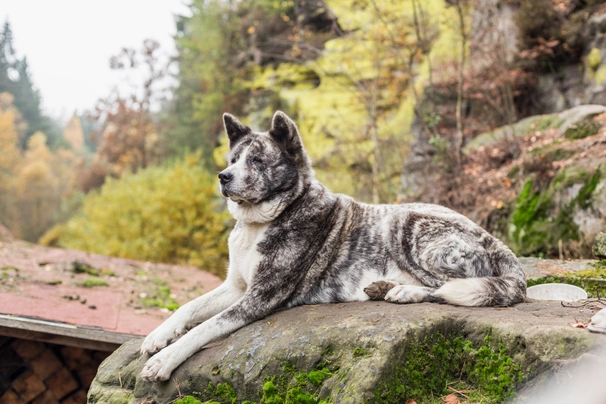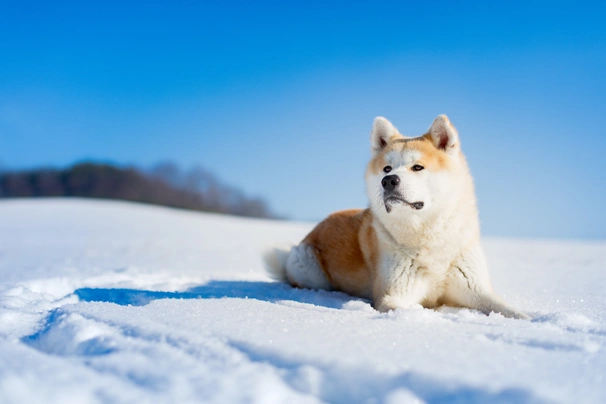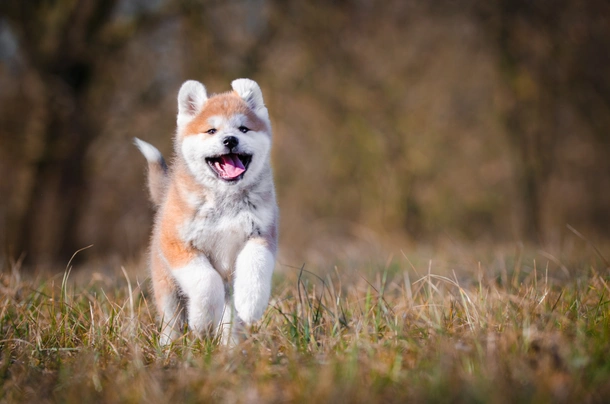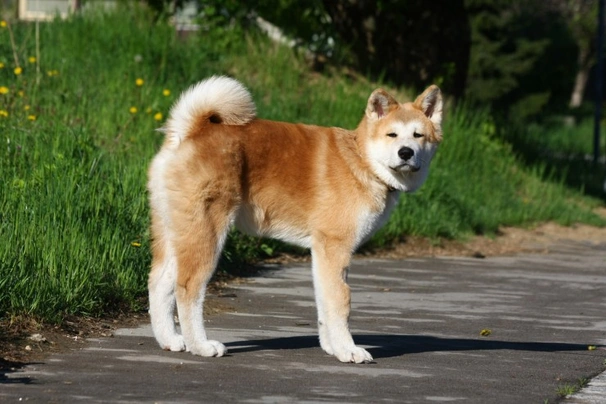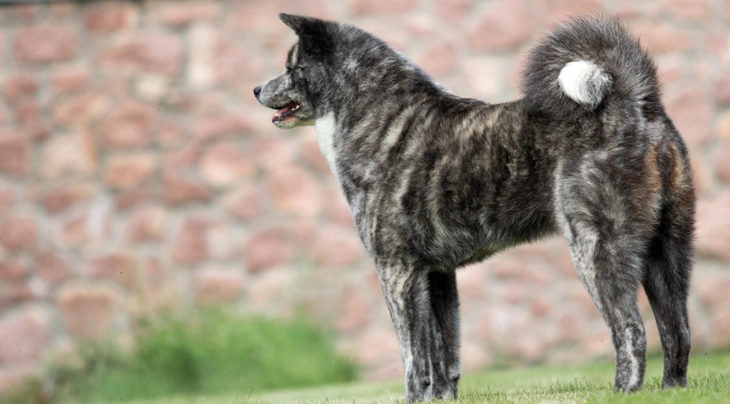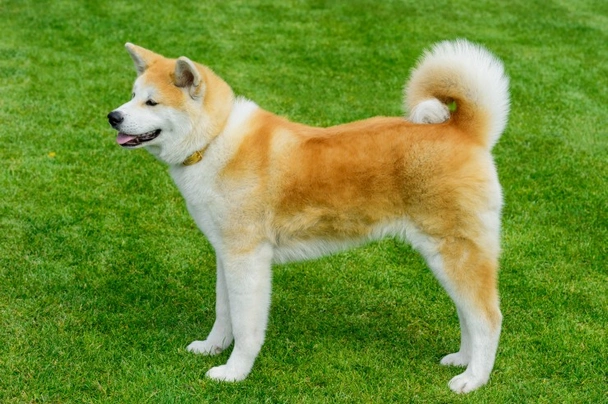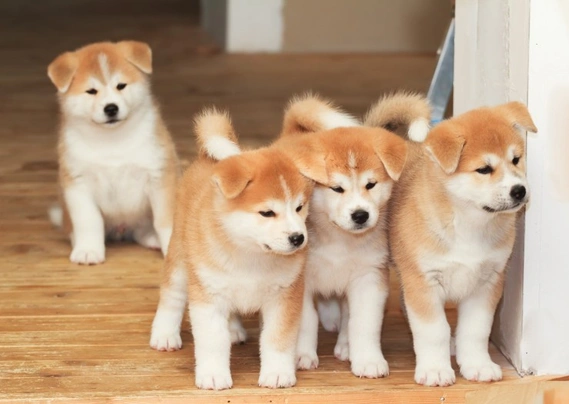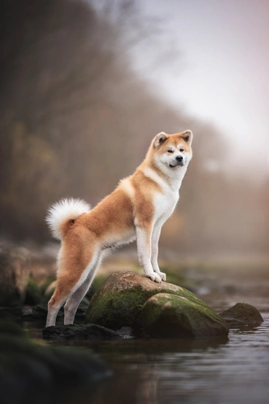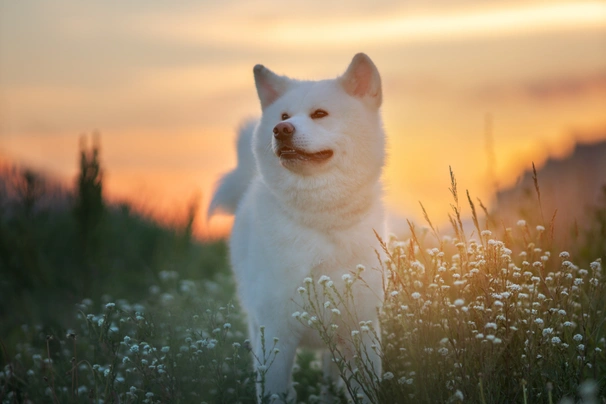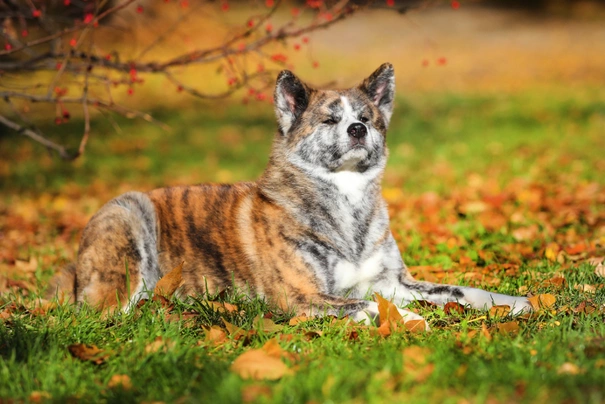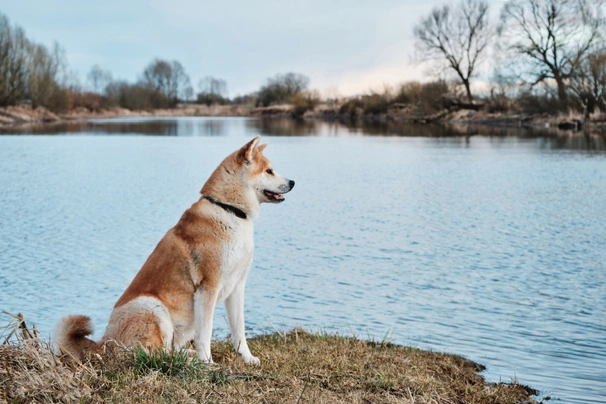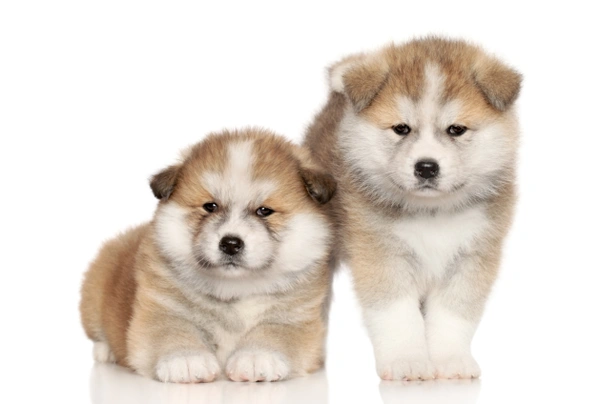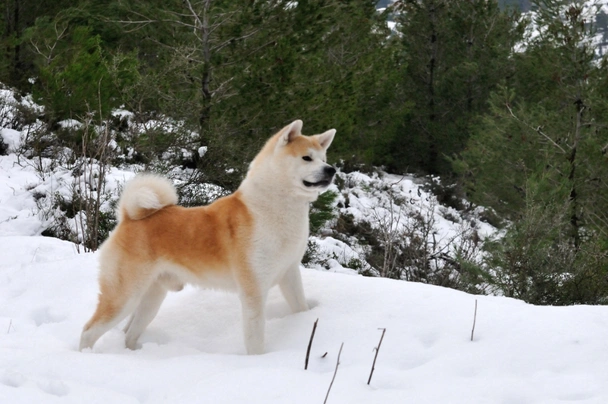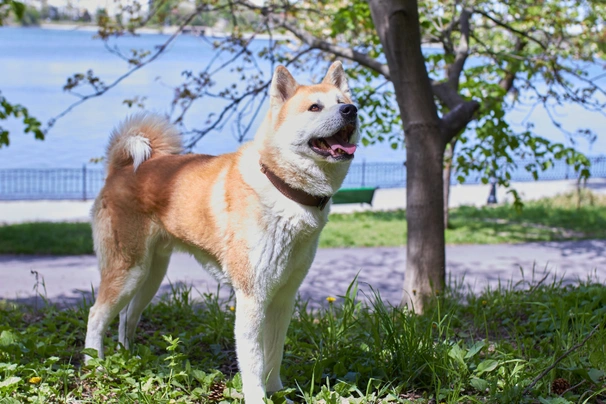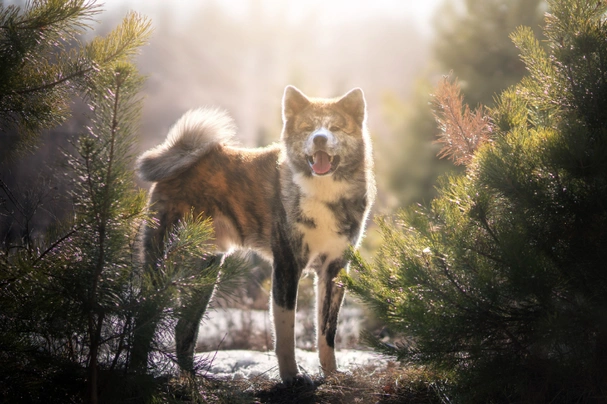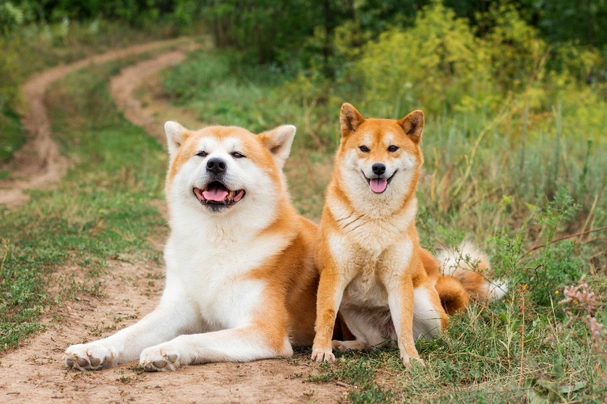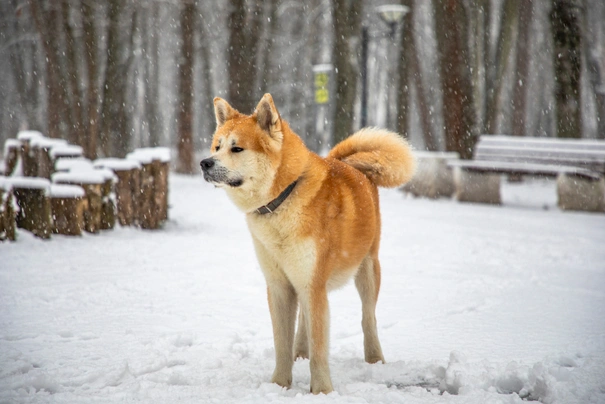Akita
Pros
Cons
Introduction of the Akita
The Akita is known to be an intelligent bright yet reserved and possessive dog by nature. However they should never be timid nor should they be aggressive but rather an Akita should be dignified courageous and affectionate. They will defend their families without a second thought which in short means they make excellent watchdogs. Today the Akita has fast become a popular breed in the UK and elsewhere in the world for good reason because when well socialised they make wonderful companions and family pets. The breed is native to Japan where the breed has always been highly regarded not only for their dignified proud looks but also for their loyalty and devotion to their owners as well.
There are in fact two types of Akita and although very similar there are slight differences in appearance with the Japanese Akita being quite a bit lighter and smaller than the American Akita. They are part of the "Spitz" type of dog and have been around for around 300 years in their native Japan where they were bred as fighting dogs but this changed and Akitas were used to hunt deer wild boar and black bears.
The Akita is an impressive looking and courageous dog but one that needs to be well socialised and trained from a young age to be a truly well-rounded dog. As such they are not the best choice for first-time dog owners but do very well with people who know how to handle and manage them.
History of the Akita
Akitas have a fascinating history with early records showing that these proud dogs were once not only highly prized as hunting and fighting dogs but also as "good eating" in their native Japan. Their fur was used to make warm clothes and Akitas were also used by Japanese fishermen to herd fish into their nets. With this said the actual history of the breed has been lost in time having become a little blurred over the centuries thanks to various translations from Japanese to other languages.
There is some evidence of similar looking dogs with erect ears and tightly curled tails having been around in 1150 AD and that dogs called Matagiinu having been highly prized by Japanese royalty for their hunting skills. At one point in history only Japanese rulers could own an Akita and they gave their dogs unique collars that showed an owner's rank.
Over the following centuries the Akita's popularity went through various stages of highs and lows but it was during the Emperor Taisho's reign at the turn of the 20th Century that their popularity rose again after the breed became prized in other countries of the world which included the UK Spain and France where Akitas had become status symbols with royals and other people alike.
Today's Akita owes much of their lineage and ancestry to the dogs that were breed in a mountainous region of Japan known as the Akita Prefecture although these dogs were bred and raised in many other regions of the land too. The Akita Inu Hozankai Society began recording a stud book in 1927 which kept a record of all parents and litters produced in Japan and the stud book still exists today with an end goal being to keep the breed as pure as possible in modern times.
More about Odate Dogs
The Akita was originally known as the Odate dog and they were first recognised as a national treasure in Japan in 1931 having been established as a "pure" breed by the Mayor of a region called Odate which is the capitol of the Akita Prefecture. This is the most northern province on the island of Honshu in Japan. It was the custom in Japan to name dogs after the region in which they were bred and as such the Odate became known as the Akita Inu which translated means Akita dog. They were the biggest among seven other Akita-type dogs that existed in 1931 in Japan. From that time onwards records of the Akita were carefully kept with the end goal being the breed’s continued success.
At the outset of the WWII and following the end of the war the numbers and popularity of the Akita fell thanks to the fact their fur and meat were in high demand which led to the breed nearly vanishing off the face of the earth forever. Luckily a few Akitas survived and once again during the late 1940's and the beginning of the 1950's breed numbers began to flourish. It was during this time that two bloodlines were established and it is from these bloodlines that most Akitas in other countries of the world are descended. It is thought that returning soldiers took Akitas back with them to their homelands which included to the UK Canada and the United States.
The breed was diversified in the early 20th century with the introduction of the 'American Akita'. In 1937 Helen Keller the famous deaf blind linguist and activist developed a fondness for the breed and was sent a dog named 'Kamikaze' who sadly died at a young age from distemper but one of his litter mates named 'Kenzan-go' was sent over to her to replace the dog she lost. From this point the Japanese and the American breeds were bred differently from each other with Americans breeding dogs with heavier larger physical traits while in Japan breeders concentrated on producing smaller dogs. Today the Akita is a well-recognised breed the world over and they have earned themselves the place in the hearts and homes of many people here in the UK too.
Interesting facts about the breed
- Is the Akita a vulnerable breed? No they are among the most popular in the UK and elsewhere in the world
- There is a museum in Odate Japan dedicated to Akitas
- Akitas were first simply known as "snow country dogs" in their native Japan where they were highly prized for the hunting skills
- The Akita is considered a "national treasure" in Japan
- They have webbed toes which helps Akitas distribute their weight more evenly when walking in snow
- Akitas cope extremely well in cold weather thanks to their coats and build
- When children are born in Japan they are given a small stature of an Akita which is thought to bring them long life and happiness
- It's thought that Helen Keller was the first person to introduce the Akita to the United States in 1937 who described the breed as being gentle and trustworthy
- In 1924 a famous Akita called Hachi-Ko was given to a Tokyo professor and when the professor died his faithful dog continued to go to the station every morning and evening as he had done every day that his owner was alive and did so for the remainder of his life. As a tribute to the dog's loyalty a statue was erected at the station
- Helen Keller was given an Akita puppy in 1937 called Kamikaze-Go that she took home to New York with her but sadly the dog died just a year later. She was then offered another Akita called Kanzan-Go a dog that remained with her until 1945
- Akitas were highly prized hunters in their native Japan
- Japanese fishermen used Akitas to herd fish into their nets and were highly prized for their water retrieving skills
- Akitas were used as herding dogs in the 17th Century in the mountain regions of Japan
- Akitas have a proven track record as being excellent sledding dogs
- Akitas have a naturally strong desire to protect and guard which often means they rarely back down when confronted
Appearance of the Akita
Height at the withers: Japanese - Males 64 - 70 cm Females 58 - 64 cm
Height at the withers: American - Males 66 - 71 cm Females 61 - 66 cm
Weight: Japanese - Males 32 - 39 kg Females 50 - 65 kg
Weight: American - Males 45 - 56 kg Females 45 - 66 kg
Akitas are large and impressive dogs and they reflect perfectly the job they were originally bred to do. They boast large heads which are well proportioned in relation to the rest of their body. Their muzzle is strong broad with well-developed cheeks. They have black noses and tight black lips although in lighter coloured dogs a little pigmentation is perfectly acceptable as a breed standard.
An Akita's eyes are quite small but nicely almond shaped set neatly apart and brown in colour although the rims are dark. Their ears too are quite small and triangular in shape with rounded tips and they are thickly set with dog's carrying them in a forward position. Their jaws are strong with a perfect scissor bite. Their necks are powerful muscular and quite short compared to the rest of their body. They boast a pronounced crest on their necks and this blends in neatly with the rest of their coat at the back of a dog's head.
Their forequarters are powerful and their front legs are well boned and straight. One thing about Akitas is that their bodies are longer than they are high with males being slightly taller than their female counterparts. An Akitas chest is deep and broad and their backs are level and well muscled. Hindquarters are powerful well-muscled with strong thighs and back legs. Their feet are tight and well-knuckled with hard nails and pads. An Akita's tail is full and large with either a full or even a double curl which dogs carry over their backs. Tails do not have any feathering on them.
When it comes to their coat an Akita boasts a coarse straight outer coat that stands well off the body with a much softer and denser undercoat which offers these dogs a tremendous amount of protection against the elements. Their coats are longer in length around the withers and rumps which can be around 5 cm in length but with no ruffs or feathering whatsoever. Akitas can be any colour and this includes pinto and brindle with the one constant being that their colour should be brilliant. Any markings on their bodies or faces are well-defined which includes a mask or a blaze. The accepted Kennel Club breed colours for registration are as follows:
- Black
- Black & White
- Brindle
- Brindle & White
- Brown & White
- Fawn & White
- Fawn & White Black Overlay
- Fawn with Black Mask
- Pinto
- Red
- Red & Black
- Red & White
- Red & White with Black Overlay
- Red Black & White
- Red with Black Mask
- Silver & Black
- Silver & White
- Silver & White Black Overlay
- Silver Fawn & White
- Silver White & Black
- Silver with Black Mask
- White
- White Fawn & Black
- White with Coloured Mask
- White with Markings
Gait/movement
When an Akita moves they do so showing a tremendous amount of vigor and power. Their strides are fluent and moderately long with dogs carrying their backs level and firm. Their back legs move in time with their front ones and Akitas often move with a single-track gait.
Faults
The Kennel Club frowns upon any exaggerations and departures from the breed standard and would judge faults on how severely they impact a dog's movement overall health and wellbeing as well as their ability to perform.
Male Akitas should have both testicles fully descended into their scrotums and it is worth noting that an Akita may be a little smaller or larger and they can be slightly taller or shorter than stated in the Kennel Club breed standard which is given as a guideline only.
Temperament of the Akita
Akitas are very intelligent dogs they are independent thinkers with strong characters which means these dogs are not the best choice for first-time dog owners. They need to be handled and trained using a gentle yet firm hand and they need to know their place in the pack to be a truly well-rounded dog. It's in an Akita's genes to protect which is what they have always been bred to do which is a trait that should never be forgotten in this breed.
It would be fair to say that an Akita has an innate quality to defend and protect which means owners should always be very careful when introducing a dog to people and that anyone who visits the home is a welcome guest. Akitas are incredibly perceptive and easily recognise people whose intentions are not welcome without the need to be trained to do so. Their independent thinking is often mistaken for dog being stubborn which is not always the case. The Akita is quick to learn new things and this means they are ultra-quick to pick up any bad habits if they are allowed or if they are not handled correctly which is something to be avoided at all costs.
Although robust and strong dogs they are quite sensitive by nature which means they benefit from positive reinforcement training and do not respond well to any heavy-handed handling. An Akita will form a very strong bond with an owner and they show their devotion in a calm and quiet way always wanting to know where an owner is but never pestering them in any way.
They are known to be very good when around elderly people with many of them being used in retirement homes and hospices as therapy dogs. However they are "bossy" dogs by nature and if left to their own devices will quickly display a dominant side to their character which is why they are not the best choice for first time dog owners.
The Akita is a good choice as a family pet but with this said and as previously mentioned it really does depend on how an Akita is socialised when young as to how they react around children. It goes without saying that kids must be taught to "behave" when they are around any dog and this includes how they act when they meet an Akita as to how the dog would react to them. It also goes without saying that any interaction between children and dogs needs to be supervised by an adult to make sure nobody gets too boisterous and that things remain nice and calm.
Are they a good choice for first time owners?
Akitas are not the best choice for first time dog owners because they need to be handled socialised and trained by people who are familiar with the breed's very specific needs. With this said in the right hands an Akita quickly becomes a valued and devoted member of the family.
What about prey drive?
Akitas as previously mentioned have an extremely strong prey drive and as such care should always be taken when and where a dog can run free and why the fencing in a back garden must be ultra-secure to keep an Akita safely in bearing in mind that they are known to be extremely good escape artists. Fences also need to be high because Akitas can leap or climb a fence with no trouble at all when they want to.
What about playfulness?
Akitas are playful and fun-loving by nature and enjoy being involved in everything that goes on in their environment. This includes family fun and games. They remain very playful well into their senior years which is another reason why sharing a home with an Akita is always lively and entertaining.
What about adaptability?
Akitas need to have enough space to express themselves as they should and as such are not suited to apartment living. They thrive in homes with large secure back gardens where they can romp to their heart's content as often as possible in a safe environment which means they get to let off a lot of steam and pent up energy.
What about separation anxiety?
Akitas form strong ties with their owners and families which in short means they are never very happy when they are left of their own for longer periods of time. They are not known to be especially destructive around the home unless they are left to their own devices and not given enough daily exercise and mental stimulation which leads to boredom setting in. The result is often unwanted behavioural issues which includes tearing up a home.
What about excessive barking?
An Akita will only bark when necessary to let an owner know there are strangers about or when something they don't like is going on in their environment. With this said if an Akita is bored they may well howl when the mood takes them as a way of telling the world how unhappy they are.
Do Akitas like water?
Most Akitas really like swimming and will happily jump in the water. They have tremendous coats that offer them lots of protection which is why they were used by fishermen in their native Japan to herd fish into their nets for them a job Akitas were particularly good at. As such great care should be taken when walking an Akita off the lead anywhere near more dangerous watercourses just in case they suddenly decide to leap in.
Are Akitas good watchdogs?
Akitas are tremendous natural watchdogs which means they don't need to be trained to protect and guard anything. In fact it would be a big mistake to attempt to train an Akita to guard anything with some breeders refusing to sell puppies to anyone they suspect might want to use them as guard dogs.
Intelligence / Trainability of the Akita
Akitas are known to be intelligent but they are "dominant" dogs by nature and as such they really do need to be handled and trained by someone who is familiar with this sort of bossy dog. Their education must start as early as possible because Akitas need to know who is the alpha dog in a household. If allowed to show the more dominant side to their character these dogs quickly become unmanageable which can make life difficult for everyone in a household.
It is worth noting that it is all too easy to "over-train" an Akita because they take their education very seriously and the end result of over training a dog would be an Akita that is not suitable as a family pet or companion. It would be fair to say that any Akita that's been trained as a watchdog would rarely fit in well in a domestic environment and why many reputable breeders would refuse to sell an Akita puppy to someone they suspect might do this.
Akitas do not respond well to any sort of harsh training or correction but they do respond well to positive reinforcement. However they need to be handled very firmly and fairly for them to become obedient well-rounded characters. It's essential for their training to be consistent and to continue throughout their lives which is another thing that should never be overlooked when living with an Akita.
The one thing that should never be forgotten about an Akita is their strong prey drive and although they could well accept being around a family cat it would never be wise to trust with a cat or other pet they don't know which could well end up being disastrous.
Akita puppies must be taught the ground rules and boundaries from the word go so they understand not only their place in the pack but also what an owner expects of them. Their socialisation should have already started when they were with the breeders and any responsible breeder would ensure that their puppies are introduced to a home environment lots of people and other animals before they even consider selling them. An Akita puppy's education should include them being taught the basic commands as soon as they arrive in a new home paying special attention to the "recall" and "leave it" commands. The other commands puppies must be taught include the following:
- Sit
- Stay
- Down
- Heel
- Quiet
Children and other
Akitas are known to be tolerant around children in their household preferring to keep out of the way if things get too noisy or boisterous. However because they form strong ties with their families and naturally feel they need to protect the kids care should always be taken when the children have any friends over to play because of an Akita's need to protect their family. With this said Akitas make the best play mates because of they have so much stamina and are fun-loving dogs by nature which means they become great buddies with children of all ages they have grown up with. It is worth noting that an Akita never handles too many children around at any one time which is when it would be better and safer to keep a dog well out of the way.
A few breeders advise that the temperament of an Akita depends on how well they are socialised as puppies but this is only part of the equation because a dog's disposition and character also depends on how they are treated in the first months of their lives and how they are handled and trained with socialisation and genetics also playing a crucial part in an Akita’s make-up.
More about aggressive behaviours towards other dogs
It would be fair to say that Akitas are known to be "dog-aggressive" and therefore should not be trusted around other dogs even when they have grown up together. As such an Akita should not be allowed to run free when other dogs are in the area. Mature dogs should be walked with good quality well-fitting collars and strong short leads because keeping an Akita under control when they are near other dogs is of paramount importance bearing in mind that Akitas are not only powerful but they are strong willed too and if they feel challenged in any way they will not back down.
More about aggressive behaviour towards people
If not correctly socialised many reputable breeders advise that Akitas can be "people-aggressive". In short puppies and young Akitas must be introduced to as many new situations and people as often as possible to curb this natural instinct. Once a puppy is fully vaccinated it is essential for them to meet as many people as possible all the time keeping them on their leads and this must be done when an Akita puppy is still young when they are that much more receptive to having their characters gently moulded.
It is worth noting that a few Akitas do not become aggressive towards people they don't know until they are 1-year old or so which is typically when they start to show a more dominant side to their natures. This attitude towards people only applies to strangers and not to an Akitas family. In the home environment they are loving and devoted although stubborn when the mood takes them. Once an Akita is mature they tend to be more aggressive towards people they don't know and other animals which includes dogs.
Health of the Akita
The average life expectancy of an Akita is between 10 and 11 years when properly cared for and fed an appropriate good quality diet to suit their ages.
Akitas are generally healthy dogs but they are known to suffer from certain hereditary and acquired disorders as well as being very sensitive to drugs often used in veterinary care and more especially to anaesthetics. The health disorders the breed is more prone to suffer from includes the following:
- Mycrocytosis – a blood disorder
- Autoimmune Hypothyroiditis – studies have shown that a high percentage of Akitas suffer from this condition which negatively impacts a dog’s immune system. Stud dogs should be tested before being used for breeding purposes
- Akita thyroid – which causes skin disorders
- Bloat
- Hip Dysplasia - KC/BVA tests available
- Luxating Patella – dogs with the condition should not be used for breeding purposes because it is thought to be an hereditary disorder
- Von Willebrand's Disease – studies have shown that up to 20% of Akitas suffer from the condition
- Summer Stress - Akitas find it hard to cope with extremely hot weather
- Vestibular Syndrome
Some Akitas are ultra-sensitive to certain drugs and medication which includes sedatives and anaesthesia which owners must remind a vet about should a dog need to be treated for any disease or condition. They can also have a negative reaction to some travel-sickness pills and many reputable breeders recommend that owners have their Akitas blood tested to check on the state of a dog's immunity before administering a vaccination or booster.
What about vaccinations?
An Akita puppy would have been vaccinated before being sold but it is up to the new owner to ensure that a dog is given any follow-up inoculations but as previously mentioned it is worth having a vet carry out a blood test on a dog before giving them boosters. The vaccination schedule for dogs is as follows:
- 10 -12 weeks old bearing in mind that a puppy would not have full protection straight away but would be fully protected 2 weeks after they have had their second vaccination
There has been a lot of discussion about the need for dogs to have boosters. As such it's best to talk to a vet before making a final decision on whether a dog should continue to have annual vaccinations which are known as boosters.
What about spaying and neutering?
Over the years there has been a lot of research into when a dog should be spayed or neutered. At one time the consensus was that females should be spayed when they are 6 months old and males neutered when they are 6-months old too. However new studies suggest that it is far better to wait until a female is around 1-year old and the same goes for male dogs because it means they have developed and matured that much more before undergoing the procedures.
What about obesity problems?
Some Akitas can put on weight once they have been spayed or neutered so it is important to keep an eye on a dog's waistline and to adjust their calorie intake and daily exercise accordingly. Older dogs are also more likely to put on weight and again it's essential that an Akita when they reach their golden years they be fed an appropriate diet to suit their ages. When dogs carry too much weight it can shorten their lives by several years because it puts a lot more strain on their hearts other internal organs and their joints.
What about allergies?
Most Akitas are not known to suffer from food allergies but many reputable breeders recommend that dogs be fed a gluten-free diet. Many owners choose to feed their Akitas a Bones as Raw Food diet (BARF) which appears to be a well-balanced feeding routine for the breed. However it is best to discuss things with a vet before feeding this type of diet to an Akita.
With this said the breed is known to suffer from a condition known as Akita thyroid which can cause skin disorders and any dog that develops the problem needs to be seen by a vet and treated as early as possible to make sure they are made to feel more comfortable while a correct diagnosis can be made. What may appear to be a skin issue could well turn out to be something a lot more serious that negatively impacts a dog’s vital internal organs.
Participating in health issues
It is mandatory for all Kennel Club Assured Breeders to have their stud dogs tested using the following KC/BVA scheme and the Kennel Club strongly recommends that all other breeders follow suit:
The Kennel Club also strongly recommends that all breeders have their stud dogs tested using the following BVA/KC scheme:
It is also essential that any prospective owners discuss other health issues and tests that are available for Akitas before buying a puppy from them.
What about breed specific breeding restrictions?
Apart from the standard Kennel Club breeding guidelines for Akitas currently there are no other breed specific breeding restrictions in place.
What about Assured Breeder Requirements?
It is mandatory for all Kennel Club Assured Breeders to have their stud dogs tested using the following KC/BVA scheme and the Kennel Club strongly recommends that all other breeders follow suit:
The Kennel Club also strongly recommends that all breeders have their stud dogs tested using the following BVA/KC scheme:
It is also essential that any prospective owners discuss other health issues and tests that are available for Akitas before buying a puppy from them.
Caring for the Akita
As with any other breed an Akita needs to be groomed on a regular basis to make sure their coats and skin are kept in tip-top condition. They also need to be given regular daily exercise to make sure they remain fit and healthy. On top of this an Akita needs to be fed good quality food that meets all their nutritional needs throughout their lives.
Caring for an Akita puppy
Akita puppies are boisterous playful and they are extremely good escape artists which is why it is essential for homes and gardens to be extremely well puppy-proofed. Electric cables and wires must be put out of a puppy's reach just in case they decide to chew on them. Valuables should be put out of harm's way just in case they get knocked over and broken. Garden fences must be checked and toxic plants removed from flower beds. Tools and other implements should be put away to prevent a boisterous puppy from injuring themselves on anything.
Timing when a new puppy arrives in the home takes a bit of planning and it's best to organise it so that someone is around for the first week or so of a puppy’s arrival which goes a long way in helping them to settle in. A well socialised Akita puppy is usually outgoing but they would still be feeling a little stressed having just left their mother and littermates. As such a puppy needs a lot of reassurance and company for the first few days of their arrival in a new home with all the new sounds and smells.
It is a good idea to limit where a young Akita puppy can roam around the home and a good way of doing this is to fit good quality strong child gates on certain doors bearing in mind that an Akita puppy is smart and often figures out how to climb over them. Puppies also need to nap a lot during the day so it's important to set up a crate or dog bed in a quieter area which does not have too much traffic. However a puppy needs to know someone is around and that they are not alone. It's also important to be able to hear a puppy just in case they get themselves into trouble.
The documentation a breeder provides for a puppy must have all the details of their worming date and the product used as well as the information relating to their microchip. It is essential for puppies to be wormed again keeping to a schedule which is as follows:
- Puppies should be wormed at 6 months old
- They need to be wormed again when they are 8 months old
- Puppies should be wormed when they are 10 months old
- They need to be wormed when they are 12 months old
Things you'll need for your puppy
Needless to say there are certain items that new owners need to already have in the home prior to bringing a new puppy home. It's often a good idea to restrict how much space a puppy plays in more especially when you can't keep an eye on what they get up to bearing in mind that puppies are often quite boisterous which means investing in puppy gates or a large enough playpen that allows a Akita puppy the room to express themselves while keeping them safe too. The items needed are therefore as follows:
- Good quality puppy or baby gates to fit on doors
- A good well-made playpen that's large enough for a Akita puppy to play in so they can really express themselves as puppies like to do
- Lots of well-made toys which must include good quality chews suitable for puppies to gnaw on bearing in mind that a puppy will start teething anything from when they are 3 to 8 months old
- Good quality feed and water bowls which ideally should be ceramic rather than plastic or metal
- A grooming glove
- A slicker brush or soft bristle brush
- Dog specific toothpaste and a toothbrush
- Scissors with rounded ends
- Nail clippers
- Puppy shampoo and conditioner which must be specifically formulated for use on dogs
- A well-made dog collar or harness
- A couple of strong dog leads
- A well-made dog bed that's not too small or too big
- A well-made dog crate for use in the car and in the home that's large enough for a Akita puppy to move around in
- Baby blankets to put in your Akita's crate and in their beds for when they want to nap or go to sleep at night
Keeping the noise down
All puppies are sensitive to noise including Akita puppies. It's important to keep the noise levels down when a new puppy arrives in the home. TVs and music should not be played too loud which could end up stressing a small puppy out.
Keeping vet appointments
As previously mentioned an Akita puppy would have been given their initial vaccination after which time it is up to the new owner to discuss things with a vet before giving a puppy their follow-up shot. The usual vaccination schedule is as follows:
- 10 -12 weeks old bearing in mind that a puppy would not have full protection straight away but would only be fully protected 2 weeks after they have had their second vaccination
When it comes to boosters it's best to discuss these with a vet because there is a lot of debate about whether a dog really needs them after a certain time. However if a dog ever needed to go into kennels their vaccinations would need to be fully up to date for them to be accepted.
What about older Akitas when they reach their senior years?
Older Akitas need lots of special care because as they reach their golden years they are more at risk of developing certain health concerns. Physically an Akita will start to have a greying muzzle but there will be other noticeable changes too which includes the following:
- Coats become coarser
- A loss of muscle tone
- Akitas can either become overweight or underweight
- They have reduced strength and stamina
- Older Akitas have difficulty regulating their body temperature
- They often develop arthritis
- Immune systems do not work as efficiently as they once did which means older Akitas are more susceptible to infections
Older Akitas change mentally too which means their response time tends to be slower as such they develop the following:
- They respond less to external stimuli due to impaired vision or hearing
- They tend to be a little pickier about their food
- They have a lower pain threshold
- Become intolerant of any change
- Often an older Akita can feel disorientated
Living with a Akita in their golden years means taking on a few more responsibilities but these are easily managed and should include taking a look at their diet the amount of exercise they are given how often their dog beds need changing and keeping an eye on the condition of their teeth.
Older Akitas need to be fed a good quality diet that meets their needs at this stage of their lives all the while keeping a close eye on a dog's weight. A rough feeding guide for older Akitas is as follows bearing in mind they should be fed highly digestible food that does not contain any additives:
- Protein content should be anything from 14 – 21%
- Fat content should be less than 10%
- Fibre content should be less than 4%
- Calcium content should be 0.5 – 0.8%
- Phosphorous content should be 0.4 – 0.7%
- Sodium content should be 0.2 – 0.4%
Older Akitas don't need to be given the same amount of daily exercise as a younger dog but they still need the right amount of physical activity to maintain muscle tone and to prevent a dog from putting on too much weight. All dogs need access to fresh clean water and this is especially true of older dogs when they reach their golden years because they are more at risk of developing kidney disorders
Grooming of the Akita
Akitas have thick coats and they do tend to shed quite a bit which means they need a lot in the way of grooming to keep on top of any loose hair. These dogs love a routine which means it's always a good idea to set up a daily or weekly grooming session which a dog would then look forward to. Puppies need to be taught early that grooming and touching ears paws and nails is a nice experience and one they find extremely pleasant enjoying the one-to-one attention they are given.
As with other breeds the Akita sheds the most during the Spring and then again in the autumn when more frequent brushing would be necessary. It is worth noting that when an Akita sheds their hair can come out in clumps which can be worrying for anyone who is not familiar with the breed. These dogs also really benefit from being professionally groomed at least three times a year. When it comes to bathing this needs to be a few times a year or when necessary. However getting an Akita's coat wet is not as easy as it sounds which is why it's often easier to leave the task up to a professional groomer who would also ensure a dog's coat is completely dried off after they've been bathed too.
Exercise of the Akita
Akitas are large and very intelligent dogs which means they need to be given a lot of daily exercise and mental stimulation to be truly happy well-rounded dogs. Ideally an Akita needs to be taken for a good hour's walk twice a day and if possible to let them off their leads so they can really let off steam. However this should only be done in a safe environment where there are no other animals or livestock around due to an Akita's a high prey drive. It's important never to forget these dogs were bred for hunting a trait they still retain.
Akitas should be let out into a back garden as often as possible but the garden needs to be made ultra-secure or you may find a dog would find their way out of it when the mood takes them and they are known to be great escape artists.
Feeding of the Akita
Akitas suffer from bloat/gastric torsion and as such it's not a good idea to feed them one big meal a day. It's far better to split the amount you feed a dog into two meals and feed them once in the morning and then again in the evening.
Puppies need to be fed a good quality well-balanced diet and the breeder would have given you their feeding schedule when you picked the puppy up from them. It's essential to keep to a feeding routine when you first get a puppy or you may find they suffer a serious tummy upset. You can change their diet but this needs to be done gradually over a period of time and if a puppy gets an upset tummy to put them back on their original diet. You should then discuss things with the vet before attempting to change their food again.
Older dogs need to be fed a good quality well-balanced diet that meets all their nutritional needs. Although Akitas are not known to be fussy eaters it would be a mistake to put them on a lower quality dog food because it would not contain the right levels of minerals vitamins and other nutrients a dog needs to remain healthy.
Feeding guide for an Akita puppy
Puppies need a lot extra in the way of nutrients for them to grow and develop properly so it’s essential for them to be fed a good quality appropriated diet. As a rough guide an Akita puppy should be fed the following amounts every day spreading their meals out to 3 or 4 a day:
- 2 months old - 264g to 307g depending on puppy's build
- 3 months old - 327g to 403g depending on puppy's build
- 4 months old - 354g to 445g depending on puppy's build
- 5 months old - 381g to 527g depending on puppy's build
- 6 months old - 405g to 599g depending on puppy's build
- 7 months old - 403g to 600g depending on puppy's build
- 8 months old - 374g to 596g depending on puppy's build
- 9 months old - 349g to 556g depending on puppy's build
- 10 months old - 318g to 520g depending on puppy's build
- 11 months old - 290g to 475g depending on puppy's build
- 12 months old - 288g to 433g depending on puppy's build
- 13 months old - 286g to 430g depending on puppy's build
- 14 months old - 286g to 395g depending on puppy's build
Once an Akita puppy is 15 months old they can be fed adult dog food.
Feeding guide for an adult Akita
Once an Akita reaches maturity they must be fed a correct diet that contains all the nutrients they need to stay fit and healthy. As a rough guide an adult Akita can be fed the following amounts every day spreading their meals out to 2 or 3 a day as it is better to feed them smaller amounts several times a day to reduce the risk of them developing bloat:
- Dogs weighing 32kg can be fed 322g to 424g depending on activity
- Dogs weighing 39 kg can be fed 366g to 482g depending on activity
- Dogs weighing 45 kg can be fed 409g to 538g depending on activity
- Dogs weighing 50 kg can be fed 437g to 566g depending on activity
- Dogs weighing 55 kg can be fed 451g to 580g depending on activity
- Dogs weighing 60 kg can be fed 465g to 594g depending on activity
- Dogs weighing 66 kg can be fed 479g to 608g depending on activity
Akita price
If you are looking to buy an Akita you would need to be prepared to pay anything from £300 to well over £600 for a well-bred pedigree puppy. The cost of insuring a male 3-year old Akita in northern England would be £48.62 a month for basic cover but for a lifetime policy this would set you back £74.20 a month (quote as of August 2017). When insurance companies calculate pet insurance they factor in a few things and this includes where you live in the UK and a dog's age and breed.
When it comes to food costs you need to buy the best quality food whether wet or dry to feed your dog throughout their lives making sure it suits the different stages of their lives. This would set you back between £40 - £60 a month. On top of this you would need to factor in veterinary costs if you want to share your home with an Akita which includes their initial vaccinations their boosters the cost of neutering or spaying your dog when the time is right and then their annual health check visits all of which can quickly add up to well over a £1200 a year.
As a rough guide the average cost to keep and care for an Akita would be between £110 to £140 a month depending on the level of insurance cover you opt to buy for your dog but this does not include the initial cost of buying a well-bred pedigree Akita puppy.
Buying advice
When visiting and buying any puppy or dog there are many important things to consider and questions to ask of the breeder/seller. You can read our generic puppy/dog advice here which includes making sure you see the puppy with its mother and to verify that the dog has been wormed and microchipped.
Akitas are an extremely popular breed both in the UK and elsewhere in the world which means that well-bred puppies command a lot of money. As such with Akitas there is specific advice questions and protocols to follow when buying a puppy which are as follows:
- Beware of online scams and how to avoid them. You may see online and other adverts by scammers showing images of beautiful Akitapuppies for sale at very low prices. However the sellers ask buyers for money up front before agreeing to deliver a puppy to a new home. Potential buyers should never buy a puppy unseen and should never pay a deposit or any other money online to a seller. You should always visit the pet at the sellers home to confirm they are genuine and make a note of their address.
- As previously touched upon Akitas are among the most popular breeds in the UK. As such there are many amateur breeders/people who breed from an Akita far too often so they can make a quick profit without caring for the welfare of the puppies their dam or the breed in general. Under Kennel Club rules a dam can only produce 4 litters and she must be between a certain age to do so. Anyone wishing to buy an Akita puppy should think very carefully about who they purchase their puppy from and should always ask to see the relevant paperwork pertaining to a puppy's lineage their vaccinations and their microchipping
- It is essential that prospective owners visit breeders to see how Akita puppies have been raised and to establish how well they have been socialised in the first weeks of their lives. It is also essential to meet both the mother and the father to see how well they accept being around people they don't already know. Many reputable Akita breeders will not let a puppy go to a home where they may be trained and used as watchdogs which could lead to an Akita becoming more dominant and therefore a lot more aggressive

American Akita Vayler
£750
KC REGISTERED AKITA PUPS
£1,500
